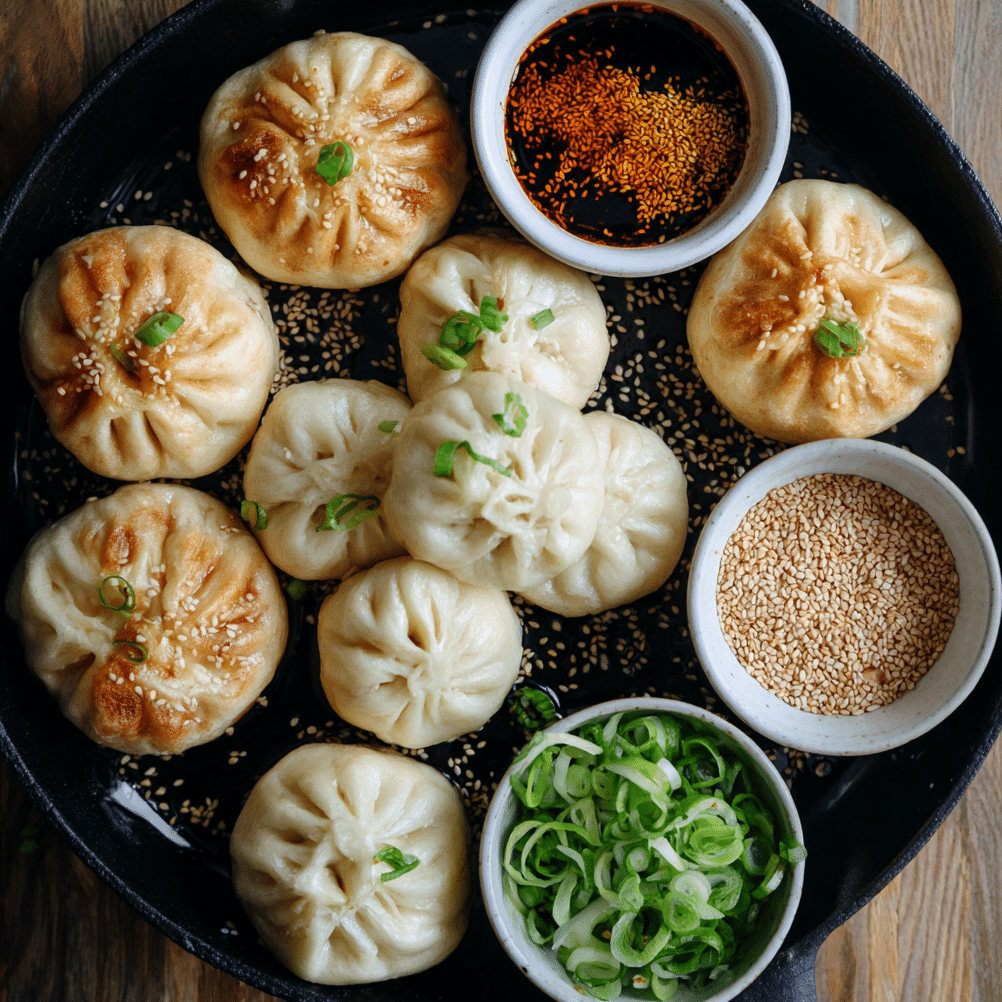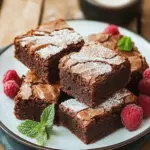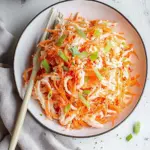The famous Sheng Jian Bao, or Shanghai Pan-Fried Soup Dumplings, are a delightful twist on the classic steamed bao. These dumplings are known for their juicy pork filling encased in a fluffy yet crisp-bottomed dough wrapper. Each bite delivers a perfect blend of umami-rich soup, tender pork, and a beautifully golden crust.
Traditionally served as a breakfast or snack food on the bustling streets of Shanghai, Sheng Jian Bao have become a beloved delicacy across the world. Whether you’re preparing them for a special dinner or a dim sum feast, these buns offer a rewarding culinary experience and a taste of true Chinese street food magic.
Full Recipe
Ingredients:
For the Dough:
-
2 1/2 cups all-purpose flour
-
1 tsp instant yeast
-
3/4 cup warm water (plus 1-2 tbsp if needed)
-
1 tbsp sugar
-
1/4 tsp salt
For the Filling:
-
1/2 lb ground pork (preferably 20–30% fat)
-
1 tbsp light soy sauce
-
1 tbsp Shaoxing wine
-
1 tsp sesame oil
-
1/2 tsp sugar
-
1/4 tsp white pepper
-
1/4 tsp salt
-
2 tbsp ginger water (grated ginger soaked in warm water)
-
1/4 cup pork or chicken gelatin stock (cold and diced)
-
1/4 cup chopped green onions
For Cooking:
-
2 tbsp vegetable oil
-
1/2 cup water
-
1 tbsp all-purpose flour (to mix with water)
-
Sesame seeds and chopped green onions for garnish
Directions:
-
Make the Dough: Combine flour, sugar, salt, and instant yeast in a large bowl. Slowly add warm water and mix until a dough forms. Knead for 8–10 minutes until smooth and elastic. Cover and let rise for 1 hour until doubled.
-
Prepare the Filling: In a bowl, mix pork with soy sauce, Shaoxing wine, sesame oil, sugar, white pepper, and salt. Add ginger water, chopped green onions, and cold gelatin stock cubes. Stir in one direction until sticky. Chill in the fridge.
-
Form the Buns: Once the dough has risen, punch down and divide into 12 equal pieces. Roll each into a small disc. Add a spoonful of filling to the center, pleat and seal tightly into a bun shape. Let rest for 10 minutes.
-
Pan Fry & Steam: Heat oil in a non-stick skillet over medium heat. Place buns seam-side down. Cook for 2 minutes until bottoms are golden. Mix 1/2 cup water with 1 tbsp flour and carefully pour into the pan. Cover immediately and steam-fry for 7–8 minutes until water is evaporated and bottoms are crispy.
-
Garnish: Sprinkle with sesame seeds and chopped green onions before serving.
Prep Time: 1 hour 30 minutes | Cooking Time: 15 minutes | Total Time: 1 hour 45 minutes
Kcal: 185 kcal per bun | Servings: 12 buns
The Legacy of Sheng Jian Bao
Sheng Jian Bao (生煎包), also known as pan-fried soup buns, is one of Shanghai’s most beloved street foods and a shining example of regional Chinese cuisine. With over a century of history, this iconic dumpling originated in Shanghai in the early 1900s, often sold in bustling breakfast stalls and tea houses. Unlike its more internationally recognized cousin, xiao long bao (steamed soup dumplings), Sheng Jian Bao is pan-fried until the base becomes crisp and golden, while the top remains soft and pillowy. Inside, a burst of hot pork broth greets the eater, making every bite an exciting combination of textures and flavors. It’s a dish that perfectly embodies the warmth and energy of Shanghai.
What Makes Sheng Jian Bao Unique?
One of the defining characteristics of Sheng Jian Bao is its cooking method—a hybrid of steaming and pan-frying. This dual process results in a dumpling that is simultaneously crispy on the bottom and soft on the top. The dough used is slightly thicker and breadier than other dumplings, allowing it to maintain integrity when filled with both pork and broth. The juicy filling is achieved by incorporating gelatin-rich broth (often pork stock that’s been cooled and diced) into the meat mixture, which melts as the buns cook, creating a luxurious soup inside.
The contrast of textures—fluffy top, crispy bottom, juicy interior—is what sets Sheng Jian Bao apart from other Chinese dumplings. It’s often garnished with sesame seeds and chopped scallions, adding aromatic and nutty notes to an already flavorful bite.
Cultural Significance in Chinese Cuisine
In Shanghai and many parts of Eastern China, Sheng Jian Bao is not just a snack—it’s a cultural staple. Families will line up at local food stalls early in the morning to grab a serving for breakfast, often enjoying them with soy milk or a bowl of warm congee. In a city known for innovation and speed, Sheng Jian Bao is a quick yet hearty meal that satisfies both hunger and nostalgia.
Beyond its everyday popularity, Sheng Jian Bao has also become a symbol of culinary pride. Chefs in Shanghai take years to perfect the art of pleating the dough and controlling the cooking temperature to create that ideal crispy-yet-tender finish. Today, Sheng Jian Bao is served in both humble street carts and high-end restaurants, showcasing its versatility and widespread appeal.
Mastering the Technique at Home
Though it may seem intimidating, making Sheng Jian Bao at home is an incredibly rewarding experience. The key to success lies in a few specific techniques: using a soft, well-kneaded yeast dough; creating a well-seasoned filling with plenty of natural gelatin; and paying close attention to the cooking temperature and steam-frying process.
The pan must be covered tightly once water is added to create steam, and the dumplings should not be disturbed while frying to ensure an even golden crust. Once the water evaporates, the remaining oil crisps the bottoms to perfection. Timing is crucial—too long and the bottoms may burn; too short and they’ll be soggy. But with practice, the method becomes intuitive.
Modern Variations and Global Appeal
While the traditional filling features minced pork, many modern cooks have embraced creative interpretations. Common variations include beef, chicken, and even vegetarian fillings using mushrooms, tofu, or jackfruit. Some adventurous kitchens go a step further by adding cheese, chili, or curry flavors to the mix, making it an east-meets-west delicacy.
In Western countries, Sheng Jian Bao has found a place on the menu of upscale dim sum restaurants and food trucks alike. With the global rise in popularity of Asian street food, it’s now enjoyed by a wider audience than ever before. The bun’s portability and satisfying mouthfeel make it a fan-favorite for food festivals and home cooks alike.
Serving and Pairing Suggestions
Sheng Jian Bao is typically served fresh off the skillet, with a crispy underside and soft dome. The buns are often garnished with a sprinkle of toasted sesame seeds and finely chopped scallions. They pair beautifully with a soy-vinegar dipping sauce or a drizzle of chili oil for those who love spice.
For a more complete meal, they can be accompanied by a light broth, pickled vegetables, or a side of sautéed greens. As a breakfast item, they go well with warm soy milk or jasmine tea. In a more substantial dinner setting, Sheng Jian Bao can be one component of a dim sum platter that includes spring rolls, steamed buns, and dumplings.
Tips for First-Time Makers
If you’re new to making dumplings at home, Sheng Jian Bao might be a fun challenge to take on. Here are a few expert tips to help you get started:
-
Use bread flour or high-gluten flour for a slightly chewy yet tender texture.
-
Prepare the gelatin stock ahead of time and chill it thoroughly so it can be easily diced and incorporated into the filling.
-
Practice your pleating technique on a few dumplings before starting the batch—imperfect pleats still taste great!
-
Use a non-stick skillet or well-seasoned cast iron pan to prevent sticking and promote even browning.
-
Don’t overcrowd the pan—space the buns out so they can expand without touching.
-
Let the dough rest again after shaping to ensure fluffier tops when cooked.
Health and Nutrition Considerations
Though they may seem indulgent, Sheng Jian Bao can be relatively balanced depending on the filling and portion size. A typical pork-filled bun contains protein, healthy fats, and carbohydrates, making it a satisfying meal or snack. By using leaner meat, reducing oil, or incorporating vegetables, you can adapt the recipe to fit various dietary preferences.
Vegetarian versions using tofu or mushrooms provide a plant-based alternative with all the rich flavor and none of the meat. Using whole wheat flour for the dough is another option to increase fiber content, though it may slightly change the texture.
Why This Recipe Belongs in Your Kitchen
Sheng Jian Bao is more than just a dumpling—it’s an experience. From the moment the buns hit the hot skillet to the sizzle of water creating steam, the process of making them is a celebration of patience, texture, and flavor. It’s an impressive dish that combines artisanal skill with comforting taste.
Whether you’re a seasoned home chef or a curious beginner, this recipe offers a chance to connect with a treasured Chinese tradition in a hands-on way. With each successful batch, you’ll not only build confidence in your cooking skills but also develop a deeper appreciation for Shanghai’s rich culinary heritage.
Conclusion
Sheng Jian Bao is the kind of dish that captures hearts through simplicity and craftsmanship. Its golden, crispy base, juicy pork filling, and soft doughy top come together in perfect harmony, making it a standout in the world of Chinese dumplings. Though it may require a bit more effort and attention to detail than your average weeknight dinner, the result is nothing short of extraordinary.
Bringing the authentic flavors of Shanghai into your own kitchen allows you to explore regional Chinese cooking beyond takeout menus and dive deep into a cultural and culinary journey. And once you’ve mastered the basics, you’ll be inspired to try new fillings, experiment with techniques, and share this treasured dish with family and friends.
Sheng Jian Bao is not just food—it’s a story, a skill, and a connection to one of the most vibrant food cultures in the world.






